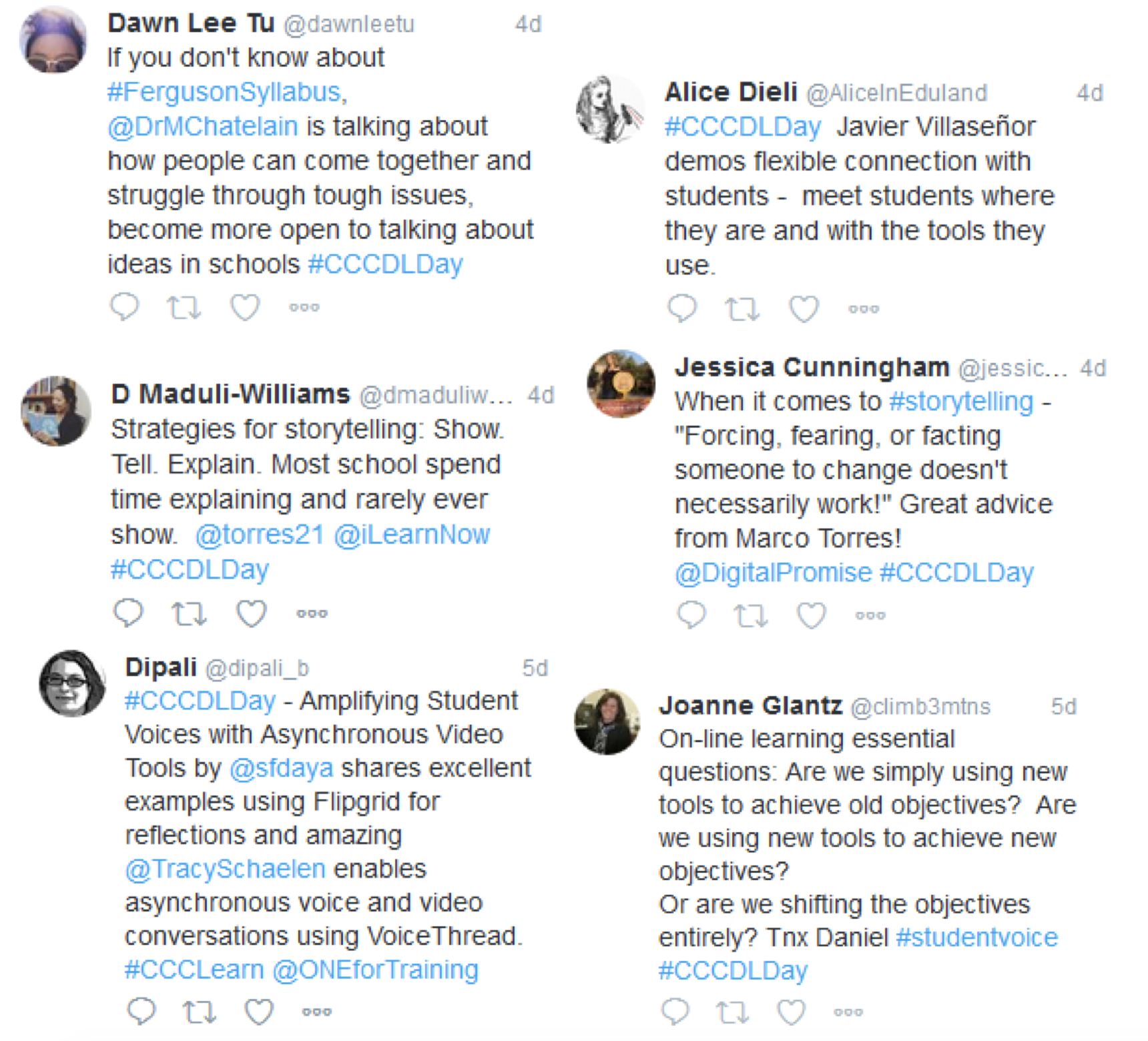You Had Me At Hello
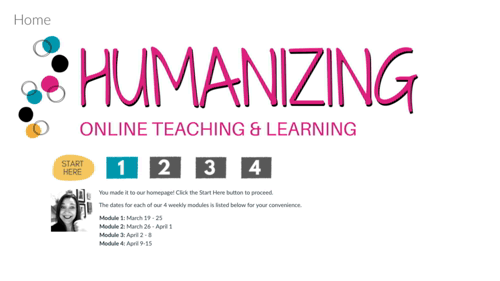 Recently, I completed the @ONE course, Humanizing Online Teaching and Learning, that was facilitated by Michelle Pacansky-Brock, @ONE’s Faculty Mentor, Digital Innovation. From the moment I logged in to the course, I knew that something drastic was about to change for me. The course homepage had a .gif of Michelle waving and smiling, a banner with colorful and inviting colors, and a greeting that made it seem like someone was talking directly to me. How, I wondered, can I do that? How can I design a homepage so my students feel as welcome and engaged as I did?
Recently, I completed the @ONE course, Humanizing Online Teaching and Learning, that was facilitated by Michelle Pacansky-Brock, @ONE’s Faculty Mentor, Digital Innovation. From the moment I logged in to the course, I knew that something drastic was about to change for me. The course homepage had a .gif of Michelle waving and smiling, a banner with colorful and inviting colors, and a greeting that made it seem like someone was talking directly to me. How, I wondered, can I do that? How can I design a homepage so my students feel as welcome and engaged as I did?
It turns out, this was only the beginning. When I first enrolled in this class, I felt a lot of pride about the way I conduct my online classes. I've been complimented in the past for the videos I create to explain essay prompts and welcome students into the class. However, as soon as I logged into our Humanizing course and began exploring, I was amazed by how much I still had left to learn.
Structure
The course started with a helpful orientation module enhanced with 3 instructor-made videos, several images, a Flipgrid assignment, a Google Form, an infographic, Canvas tutorial videos, and consistent, beautiful banners throughout. Naturally, I compared this to the orientation materials that I use, and I discovered that I’m really only using a couple of content pages that introduce students to Canvas. Never had I considered putting an entire module together to get students oriented with the course, Canvas, and policies! Essentially, I learned how I can chunk my traditional syllabus into Canvas Pages and design it into an orientation module! This approach allows students to read through the module in small pieces rather than read, say, a 14-page syllabus!
Sparkly New Toys!
In the Humanizing course, I was also introduced to a ton of new tools to use in Canvas that can help to humanize us as the instructors and our students as well.
Flipgrid, which is like a video discussion board, was a tool that I felt a little timid about using at first. However, after watching my colleagues post their video responses, I realized it was very similar to having an in-class discussion. As someone who is particularly shy in a student setting, I can empathize with my students who may feel the same way. However, once I got past simply recording my video and talking to the camera, it was smooth sailing!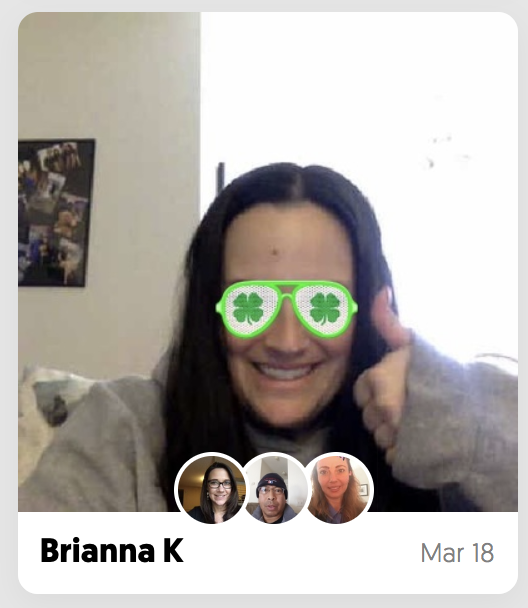
The tool asked me to take a quick photo of myself and add a sticker or two to create picture that would represent my comment. Being able to customize the picture allows for students to have creative license that a text-based discussion simply can’t provide in the same way. I then simply submitted my recording and could see a grid of all the other participants who had posted their videos. All of the pictures of participants were arranged in a checkerboard grid, so I could become familiar with my peers’ names and faces. This is something that I had never known how to do in an online setting.
After working with Flipgrid for a couple weeks, I used it to create a "Checking In" assignment in my current online class, and my students loved it! I will definitely be integrating Flipgrid on a more regular basis in my classes, especially in the first week as an icebreaker.
Adobe Spark is another tool that has completely changed the way I conceptualize my online teaching. Adobe Spark is free and includes three separate, but equally useful and easy-to-use, tools for digital storytelling: Video, Page, and Post. Not only will I be using the Post and Video tools to introduce course concepts, but I will also be using Spark to integrate project-based learning in my classes. For example, this semester, students will be have the option to create multimedia reflections of an on-campus event as part of their final project using Spark Video or Page
Last, I had heard of Canva before, but I had never thought to use it in the ways that Michelle did in her course. Canva is a free design tool that allows people to create flyers, resumes, invitations, and so much more. What I didn’t realize, however, is that, as online instructors, we can use the tool to create engaging banners, buttons, and YouTube video thumbnail images to enhance the design of the course. This, to me, is one of the best ways to truly humanize online learning: create a color palette for the course and design consistent banners that use the same color scheme. This creates cohesion in the course and allows students to intuitively follow the structure of the course while also being engaged by the beautiful and professional designs!
Equity
The tools have really made me realize how effectively they can reach, and more importantly, retain students of color and thus begin to reduce the equity gaps that are exacerbated by online classes. These tools allow students to creatively and personally engage with the material in dynamic and intimate ways that contrast the sometimes cold experience of text-based discussion boards.Rather than simply reading text on a screen, the digital tools allow students to incorporate tone, facial expressions, and gestures, while simultaneously revealing the nuances of their identities as students and human beings. Additionally, by allowing students the creative space to use digital tools to express themselves, instructors and peers can more deeply empathize with each other. For example, in an Icebreaker, if a student discloses on Flipgrid that she is experiencing stress from her course load, work, and children at home, others can respond in a humanized way with an empathetic video.
I can't emphasize enough how much I am taking way from this @ONE course. I am thrilled to rework my online assignments and begin integrating these tools on a weekly basis. I'm even more enthusiastic to see how these changes will influence the dynamics in my courses and how many more of my students I will be able to retain!
If you are looking for a way to make your online class more warm, inviting, and community-oriented, I highly recommend Humanizing Online Learning. You’ll be engaged and learn ways to reach your students that are dynamic, creative, and authentic. You’ll have your students at “hello.”
Learn more about Humanizing Online Teaching and Learning.
Being present for our students is a true gift we can offer and these experiences with students are one of the reasons why I’ve loved teaching and being part of an academic environment my entire professional career. As teachers, we have the capacity to change lives in ways that we may not always be fully aware of in the moment. I’m certain we’ve all experienced that moment when a student returns to share some action or word we said that had a deep impact. Our engagement with students can be a big responsibility that can be fostered in many ways: a kind word, a thoughtful smile, a note of encouragement, and even a criticism that comes from a place of wanting to push a student to learn something new.
For those who have taught classes in person, we may have an easier time being in touch with our students and the energy of the classroom. I may notice when a student is having a difficult day or week or even the entire semester. I can linger after class, arrive early, or have a student crying in our office. In those moments, my hope is I am able to practice with empathy and with understanding.
Beginners’ Mind
This being present for students may come naturally for you, and for others it may take some effort. But I know we all have this capacity for empathy and understanding. In my life, I have found cultivating this for myself first has allowed me to extend this more easily to my students. It has been through 25-years of meditation practice, allowing for a deeper understanding of my mind, that I’ve been able to bring this directly into the classroom. And just like our students, a beginners’ mind in myself can keep things fresh and help me to discover new ways to work with students.
How does this all extend into my online classroom? Do I know my students in the same way I might as if we are spending three hours per week in person? Am I able to identify a student in need or crisis through the work posted online so that I might reach out and connect to the student? And, within a primarily written medium, how am I being present for my students? We can create the conditions in our online classes that allows us to know our students better and be tuned into their overall learning experience.
Creating the Conditions for Learning
It’s the humanizing work. It’s the touchy-feely stuff that can help the student feel connected to the course material, to me, and to the college as a whole. The classes I’ve taught online – library science, technology, social media and marketing – are not necessarily touchy-feely topics. But as the teacher, we set the tone. In the online environment we need to offer a little bit more of ourselves explicitly. With in-person classes, students know I have a deep sense of humor, that I always wear black, that I like to pause in class and listen to student sharing, and that I like using the white board. These characteristics are part of my character. Online students don’t easily get this part of me, but these characteristics are critical for building a classroom relationship for our semester journey.
Creating a space where communication can be open and responsive to both student learning and student needs is key to building instructor-student relationships online. This means taking risks, and it certainly means taking more time. I write about myself, I share photos or videos so they know who I am as a person, and I incorporate personal life antidotes into the learning materials. More importantly, I create as many opportunities for students to interact with me so that I know who they are as humans. This can achieved through discussion, writing assignments, or video posts. I encourage students to share content they find that is exciting for them. Anything we, as instructors, can do to bring regular, meaningful student interactions into our online class is valuable. And we can build on this foundation to create a learning environment that is grounded in communication and trust. Creating an online classroom that is similar to how I spend 3-hours a week engaging with my students in a classroom is what I try to cultivate. My goal as an online instructor is to foster these human connections to inspire learning. In the end, when I support, guide, and inspire my students, I am nourished by our deep connections as they experience life's difficulties and joys.
Ever get the sense students are jumping straight into quizzes and assignments without first taking the time to read or watch your carefully designed content? This Byte-sized session explores an often-overlooked way to use modules to easily guide students along the learning path you want them to follow.
Student-instructor relationships matter in community college classes -- regardless of whether a course is taught on-campus or online. But when you teach online, you need to be more intentional about crafting your online presence to convey yourself as a real person who cares about your students' learning.
Data shared by the Community College Research Center shows there are some concerning gaps between the instructor-student relationships in face-to-face and online classes. Research shows that community college students feel their relationships with instructors in their face-to-face courses are more "personal," "immediate," "detailed," and "solid" when compared with their relationships with their online instructors. When learning online, students report feeling the need to teach themselves. One student in a large research study shared, "It just seems ... when you do it online, if you need help, your teacher is basically not there."
We know these student takeaways are not ok. We know instructor-student relationships are the foundation of meaningful, supportive community college learning experiences -- regardless of a course's modality. And to support faculty, @ONE is now offering a online professional development course, Humanizing Online Teaching and Learning, to introduce faculty to the relevant research about instructor presence, social presence, and culturally responsive teaching; experience a humanized online class through the lens of a student; experiment with creating micro-videos; see examples of how other faculty are applying humanizing practices in their online classes; and work through the nerves we all feel when speaking to a webcam (it really does get easier!).
Recently, I sat down with Tracy Schaelen, from Southwestern College, to explore her views about humanizing online teaching and learning. As always, Tracy provided invaluable insights about why the instructor-student relationship is so important for supporting the needs of our students, especially those from underserved populations. In the 17-minute video embedded below, Tracy also provides us with a tour of some of her own humanizing practices, which we hope will inspire you to check @ONE's course catalog and register for the next offering of Humanizing Online Teaching and Learning. Tracy will be one of the facilitators of this new course!
Announcements are an important tool in promoting regular and effective contact in an online course. But if students aren't reading your announcements, the time and effort you put into them is to no avail! In this edition of Byte-sized Canvas, we'll talk about one strategy to make sure your announcements are getting read.
In this 9-minute video, Dr. Jennifer Carlin-Goldberg from Santa Rosa Junior College shows how she uses Canvas Commons to import sample course shells with free OpenStax textbook content. Jennifer also gives us a tour of her hybrid Statistics class in Canvas and explains how she integrated OpenStax content with her own materials along with shared quizzes and YouTube videos designed to go with the OpenStax textbook.
OpenStax is a nonprofit based at Rice University that creates peer-reviewed, openly licensed textbooks available in free, digital formats to students and for a low cost in print. Since it launched in 2012, OpenStax has produced 45 textbooks in Math, Science, Social Sciences and Humanities that are free for faculty to use “as is” or to download and modify. Starting in December 2017, Canvas users can use Commons to import OpenStax content that the California Community Colleges Online Education Initiative (OEI) has embedded in Canvas course shells.
Regular and effective contact is such hot topic these days, isn’t it?
Canvas’s Announcements tool not only lets you send out fully customized class messages, but stores your communications in an easy-to-retrieve archive list. Using Announcements also supports quality course design by aligning with a number of OEI Course Design Rubric criteria. It's also a great way to create the connection that keeps students engaged and on track. What's not to love?
Let's explore the power of Announcements (in under 4 minutes!).
![]() Founded in 1998, the Foundation for California Community Colleges (Foundation) is the official 501(c)(3) auxiliary to the California Community Colleges’ Board of Governors and Chancellor’s Office. Since 1999, the Foundation has operated the CollegeBuys program to support systemwide procurement needs by leveraging the collective purchasing power of the California community colleges to create voluntary cooperative purchasing agreements.
Founded in 1998, the Foundation for California Community Colleges (Foundation) is the official 501(c)(3) auxiliary to the California Community Colleges’ Board of Governors and Chancellor’s Office. Since 1999, the Foundation has operated the CollegeBuys program to support systemwide procurement needs by leveraging the collective purchasing power of the California community colleges to create voluntary cooperative purchasing agreements.
Central to our efforts is the notion that cost should not be a barrier, and all California community college students should have equal access to educational technology tools. Through specially negotiated pricing, CollegeBuys has enabled students to purchase mobile internet service, software, and tablets/computers, which may have otherwise been unaffordable, collectively saving students, faculty, and staff millions of dollars.
One important offering that supports this work is the California Connects Mobile Internet program. A 2016 field poll by the California Emerging Technology Fund shows that 30% of Californians do not have meaningful broadband access at home, and income is a significant factor in broadband adoption rate at home. California Connects provides an affordable home internet option for students that cannot access the internet during conventional school hours. California Connects is only $19.99 a month for 30GB of data and no overage fees, and has already helped to bridge the digital divide for hundreds of students, faculty, and staff across our college system.
Awareness about California Connects and other technology offerings remains a major hurdle for our students and colleagues, so please help spread the word about these discounts on your campus. Electronic versions of outreach materials can be found at https://foundationccc.org/CollegeBuys/Champions-Materials.
To learn more about California Connects and other CollegeBuys offerings, visit http://store.collegebuys.org.
 Via the Online Counseling Network (OCN), counseling faculty statewide are participating in synchronous online counseling which allows them to replicate a face-to-face (f2f) meeting. Working this way has revealed nuances that counselors need to be aware of. I will share two today.
Via the Online Counseling Network (OCN), counseling faculty statewide are participating in synchronous online counseling which allows them to replicate a face-to-face (f2f) meeting. Working this way has revealed nuances that counselors need to be aware of. I will share two today.
Eye Contact
The position of your computer camera can impact your eye contact as it can present a nonverbal appearance that you are distracted or uninterested even though you may be staring directly at the student on your computer screen. Camera placement can make a significant difference in how you build rapport online. If you have a camera embedded in your computer monitor, I recommend you adjust your monitor to a position where your camera and eyes are horizontally aligned and level. Positioning your camera in such a manner will present a level of eye contact similar to your f2f counseling appointments. If you have a camera separate from your computer monitor, I recommend you either purchase a stand so that you can place the camera at eye level or buy a camera that you can place on the top of your computer monitor and adjust to your eye level.
Student Engagement
During an online counseling appointment, student participation is an essential component to address student learning outcomes (SLO). For example, many counseling departments include an SLO focusing on applying educational planning so that students can identify course requirements that enable a student to pursue their educational goal/s (e.g., associate degree and transfer requirements). A vital nuance is to allow students the ability to moderate some of the session so they can navigate resources such as your online catalog, key websites (e.g., assist.org), and other vital components that enable students to build a meaningful educational plan that is collaborative and critical to the learning process. As a result, students are increasing their educational cultural capital which contributes to their success and college readiness. Educational cultural capital is student’s mastery or preparedness of the college student role (Aschaffenburg & Maas, p.573, 1997). 2008), so the more educational cultural capital a student has then, the students will gain a more in-depth knowledge of their academic expectations.
One of the aspects as a community college counseling faculty I enjoy is growing my knowledge base and implementing new strategies in my counseling sessions, as this helps me become effective in my approach with students. The more you take time to engage in online synchronous counseling the more you will implement effective practices that address the nuances of online counseling. Stay tuned for future posts that discuss other nuances when providing synchronous online counseling.
To learn more about Online Counseling check out our webpage.
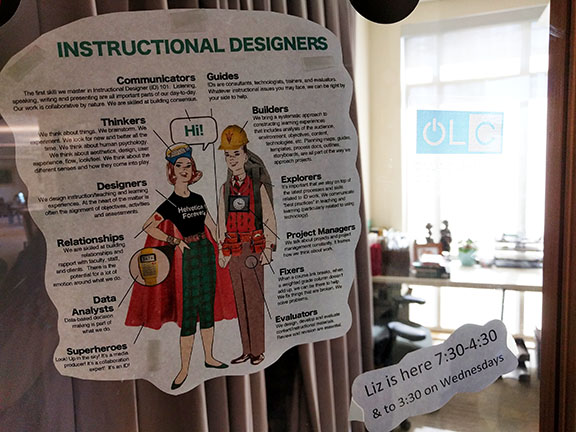
My office door with an illustration by Robert Kilman from the Arizona State University website TeachOnline
When I began my position as the Instructional Designer in Distance Education at Santa Rosa Junior College (SRJC) in the Fall of 2015, my new supervisor printed the illustration shown in the photo above and gave it to me. I taped it to my office door. Who wouldn’t like to be depicted as a fashionable superhero-explorer with a split personality? It’s also a pretty good representation of an action-packed job that marries creative thinking with technical problem-solving. Flexing different parts of my brain throughout the day keeps me excited about my work and on my toes.
Among the many roles I play, the one I reflect upon the most is Relationship Builder. The caption for the illustration states: “We are skilled at building relationships and rapport with faculty, staff, and clients. There is the potential for a lot of emotion around what we do.” The emotion was immediately evident to me at SRJC. My position was created at the same time that our college adopted Canvas to replace Moodle and a home-grown system called CATE. Emotions were loud and clear: many faculty felt overwhelmed by the transition, especially when it meant significantly reorganizing course materials to accommodate the Canvas interface.
Fortunately, many of those faculty attended our in-person Canvas workshops and appointments for help, and I was able to calm nerves by listening carefully to their concerns and providing support. I also encouraged faculty to share problems and solutions with each other. Building face-to-face relationships came easily to me and helped faculty make the transition.
Now that the transition to Canvas is complete, fewer faculty attend our in-person workshops and more often send me emails and enroll in my online courses and programs. I am happy to provide support remotely, but I find that building meaningful relationships with new faculty now requires more deliberate planning and cultivation. I’ll share two of my strategies:
- I now use ConferZoom to “meet” new faculty who take our Online Special Expertise certificate training, a six-week online course that I teach in Canvas. I offer Zoom sessions each week, and participants are required to attend at least one session. The stated purpose of this requirement is for faculty to experience the Zoom interface as a teaching tool, but I also value the sessions for relationship building. Conversations take off into many directions, just as they do in person. Sometimes the encounters are even more personal than they would be in person --I’ve met more than a few babies, kids, and pets through Zoom! I’ve also invited guests to join us, including @ONE’s Michelle Pacansky-Brock and Lené Whitley Putz.Zoom session require advance planning (although on occasion I launch Zoom screen-sharing for support calls). For the Online Special Expertise sessions, I survey participants at the start of each course to determine everyone’s availability. I then post session dates as ungraded Assignments in Canvas so the “due dates” appear in Modules, on the Calendar, and in the To Do list. I set up Outlook meetings as a reminder. I also make appointments with faculty who can’t make the sessions, and I note session attendance in Grades to be sure everyone participates. Building new relationships makes it worth the effort.
- I interview faculty for my Online Faculty Spotlight video series, which I post on our DE Blog and on YouTube. Response to the series has been very enthusiastic because a common request I hear from faculty who are new to online teaching is to see example Canvas courses. I ask the faculty I interview to imagine they are sharing their course with a colleague who has never taught online before. It’s the type of interaction that might happen informally in offices or workshops, but many of our adjunct faculty miss out on those opportunities for interaction.Some faculty I invite for interviews are hesitant to be recorded at first, but I sit next to them at my computer and we have a conversation while recording with Screencast-o-matic. I promise to edit out anything embarrassing to put them at ease. I ask them to give me a “tour” of their course and explain their teaching goals and strategies. I usually include the webcam so it’s clear who is talking. The videos foster relationships among faculty who may never meet otherwise.
My future plans, if I ever find the time, is to do a podcast. The only slack time I have during the day is lunch, so perhaps I’ll call it “Lunch with Liz at SRJC.” I won’t pull off something as slick as Teaching in Higher Ed while eating, so perhaps I’ll have informal lunch conversations with faculty about kids, pets, or favorite fonts. I keep meaning to get a Helvetica Forever t-shirt.
Learn more about the Robert Kilman's Instructional Designer infographic.
Social Reinforcement
Think about your most meaningful professional development experience over the past year. What was it? Were you sitting in your office watching a recording of a past webinar? Were you at a workshop passively listening to an expert lecture to a room full of people? Or, were you engaging in dialogue with a group of your peers? Odds are, your most meaning professional development experience didn’t occur in isolation.
Professionals attend workshops, participate in book clubs, contribute to blogs, comment on blogs, reply to Tweets, and go to conferences because these events offer social reinforcement – we derive knowledge, meaning, and professional insights from our social interactions with peers. Connecting with others—in person or online—is key to professional growth.
Peer Mentoring
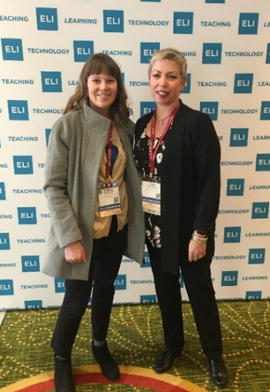
Pictured: Heather Garcia and Flower Darby, ID2ID buddies, at the ELI Conference in January, 2018.
One way to connect with others and develop professionally is to participate in a peer mentoring program or a professional community. My most meaningful professional development experience over the past year occurred in the ID2ID program. The ID2ID program is a peer mentoring program for instructional designers (IDs), sponsored by Penn State and EDUCAUSE. The program matches instructional designers and places them into mentor-mentee or buddy-buddy pairs, based on information provided by each ID during the application process. Throughout the program, the pairs meet regularly and work toward achieving their identified goals and program milestones. An outcome of participation in the program for me was presenting with my ID2ID buddy, Flower Darby, from Northern Arizona University, at the EDUCAUSE Learning Initiative (ELI) Annual Meeting in New Orleans in January 2018.
While this program may not be for everyone, if you’re in an instructional design or faculty support role, I highly recommend applying for the next cohort. It’s free! You have nothing to lose!
Making Connections Beyond Your Campus
With so many opportunities to engage with peers, why is it that so many of us continue to feel isolated? One reason might be that, as we continue to specialize in our fields more and more, we need to reach farther and wider to access people with professional experiences that we can relate to and learn from.
Schwier, Campbell, and Kenny (2004) indicate that most instructional design communities are “born of convenience” (82). These communities of convenience typically include people working in physical proximity to one another. Communities of convenience exist everywhere. You probably engage in more than one without even realizing it. While colleagues are a tremendous resource, it’s important to reach beyond our local communities to access the wealth of resources and knowledge beyond our institution’s walls.
We are lucky that we live in world, where we can use digital technologies to connect with our peers and build our communities. Not even two weeks ago, @ONE offered their first fully online, untethered conference. CCC Digital Learning Day was a remarkable success. Just take a look at some of the tweets sent by educators across our state and beyond about #CCCDLDay:
These folks got something from their digital community that they wouldn’t have experienced otherwise.
Building Your Network
So where do you go to build your network? @ONE is a great start. Their professional development offerings are designed to foster community among educators. As a current participant in their Reflective Writing Club, #CCCWrite, I am grateful for the opportunity to hear from my fellow educators, have a dialogue with them, and reflect on my practice in a supportive environment.
Another great place to get involved is the Canvas Community. The CCC Group is a place where you can connect with other California Community College educators using Canvas, ask them questions, and make feature requests. You can also find an extensive line-up of CanvasLive events in the Canvas Community.
Below you will find some other professional communities that may be of interest, especially if you are in an instructional design role. Please add to this list by sharing your own resources in the comments for this post.
- Association for Educational Communications and Technology (AECT)
- Association for Supervision and Curriculum Development (ASCD)
- Association for Talent Development (ATD)
- Educause Community Exchange
- Linkedin Higher Education Teaching and Learning
- LinkedIn Instructional Designers Group
- Loop calls through EdSurge
- Online Learning Consortium (OLC)
- Open SUNY Center for Online Teaching Excellence
- QM Instructional Designers Association (IDA)
- TopKit
- University Professional and Continuing Education Association (UPCEA)
So, get out there. Connect with a professional community. Find a professional learning network. Apply to be a part of the next ID2ID cohort. Sign up for an @ONE class. Get connected on Twitter. See you online!



